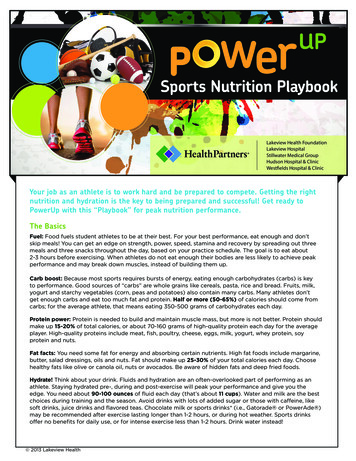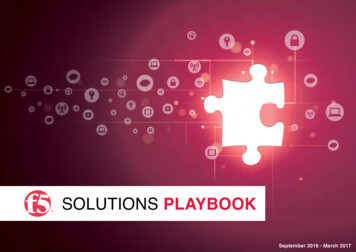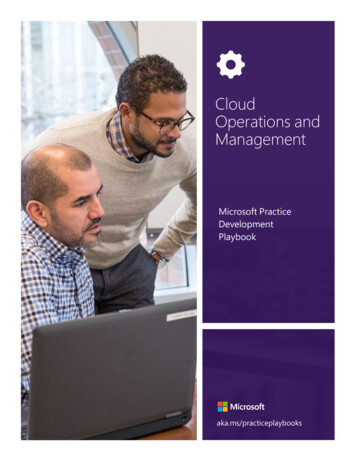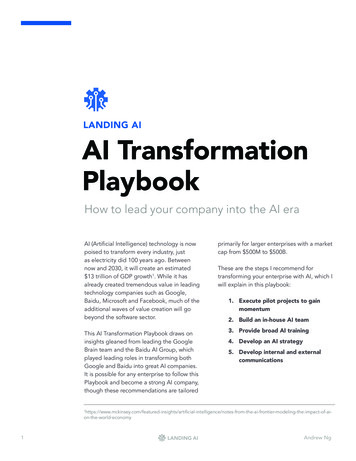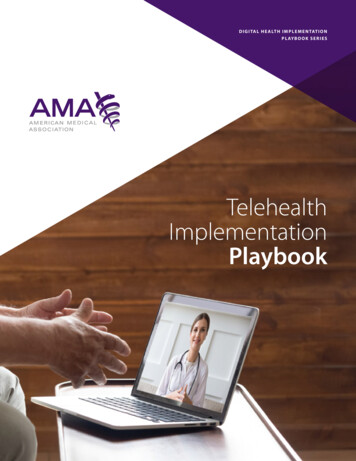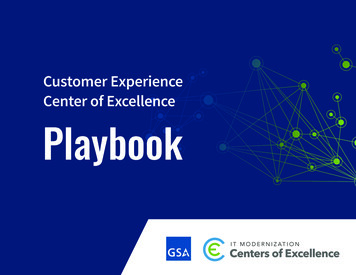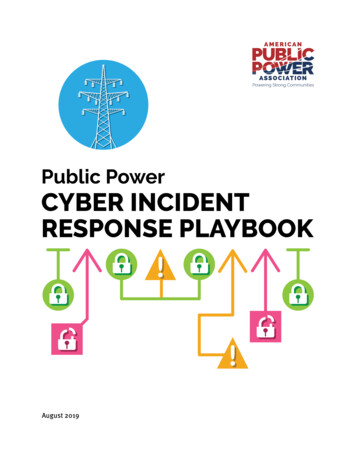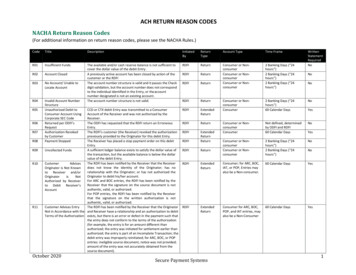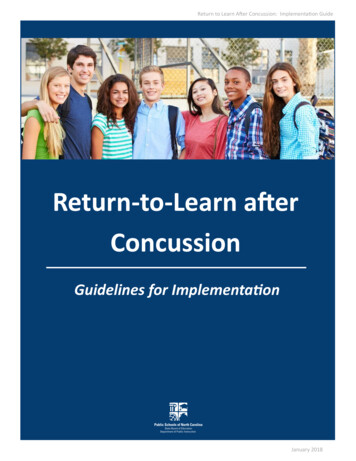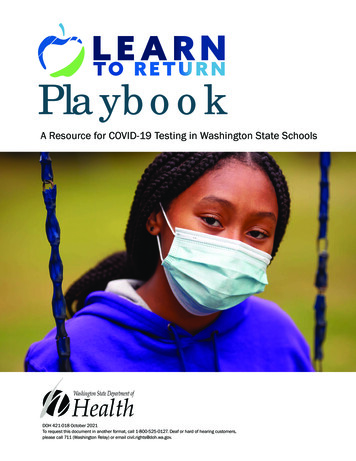
Transcription
PlaybookA Resource for COVID-19 Testing in Washington State SchoolsDOH 421-018 October 2021To request this document in another format, call 1-800-525-0127. Deaf or hard of hearing customers,please call 711 (Washington Relay) or email civil.rights@doh.wa.gov.
TABLE OF CONTENTSIntroduction . 3Partners . 3Section 1: What to Know . 4We can make in-person learning safer . 4Learn to Return supports in-person learning . 4Designed to lift the burden off schools . 5Section 2: What to Do . 6The options for testing . 6Three types of testing strategies . 6Case Study: Empower schools to design a strategy that works for theirsetting and needs. 7Diagnostic testing . 7Screening testing . 8Pooled testing . 8Figure 1: Pooled testing example . 8Test to stay . 9The tests offered in Washington state . 9Table 1: Testing technologies available to schools by DOH-vetted vendorsin Washington through the Learn to Return program . 10Choosing a staffing model . 11Section 3: How to Do It . 12Building your school's test site . 12Drive-through test sites . 13Drive-up test sites . 13Case Study: Building shared processes to implement and maintainstrong infection prevention strategies . 13Indoor test sites . 14Reporting test results . 14How to track the spread . 15Case investigation and contact tracing . 15Communication with your school . 16Touchpoints and channels for school testing . 16Messaging approach . 17Key themes for communications . 18Figure 2: Multiple layers of protection help prevent the spread of COVID-19 . 19Conclusion . 20List of resources . 20Glossary and abbreviations . 21Learn to Return Playbook 2
INTRODUCTIONSchools should be safe, secure, positive, and productive places that are the heart and soulof communities. Because of the COVID-19 pandemic, schools need extra assistance to stayopen and provide a supportive learning environment for students and their families. Learnto Return has helped Washington K-12 schools reopen — and stay open — safely. Amid theturbulence of the pandemic, Learn to Return is here to support schools as they provide asafe, positive space for student learning and development.PARTNERSLearn to Return Program is made possible through the following partnerships:The Learn to Return program is funded through the Washington State Department ofHealth (DOH) and implemented by Health Commons Project, a 501c3 Nonprofit that worksalongside schools to make COVID-19 testing possible.Learn to Return Playbook 3
SECTION 1: What to KnowWe can make in-person learning saferBy following the science and staying current on the latest research, we can return to theclassroom. We've seen that it is safe to have learning in-person, as long as we use specificsafety protocols like masking, physical distancing, ventilation, symptom screening, andcleaning. Studies from the Centers for Disease Control and Prevention (CDC) show thatschools operating in-person with proper prevention measures have experienced minimaltransmission of COVID-19. Across the United States and here in Washington, that evidencehas shown to be true — schools have safely and successfully brought students and teachersback to the classroom.Learn to Return supports in-person learningThe Washington State Department of Health (DOH) partners with Health Commons Project tooffer free and customized testing solutions for all K-12 public school districts and independent,private, and tribal schools in Washington state through the Learn to Return program.The Learn to Return program provides schools with training, strategic planning, andoperational support in designing and implementing their testing strategies. The programprovides free testing support for schools and, in turn, for students, staff, and their families.Various testing options and affiliated resources, specified later in this playbook, are availableto schools.Learn to Return Playbook 4
Designed to lift the burden off schoolsIn 2020, Learn to Return supported schools by providing diagnostic testing, and thenquickly expanded to include screening testing in 2021. The list of services has continuedto evolve so that schools can access even more: extra support staff, data managementservices, and mitigation strategies (such as school-based vaccination events andimproved ventilation systems).Learn to Return also provides a designated point person, a Health Commons programmanager, who offers one-on-one guidance to schools and school districts to: Onboard them to the Learn to Return program Help them select the testing strategy most suitable to their district/school’s needs Offer the testing technologies that work with their testing strategy Provide technical and troubleshooting assistance as the school year continuesFor more information about the Learn to Return program, visit the Learn to Return website.There you will find more resources for administrators and staff, including fast facts about theprogram and testing FAQs. School districts who want to enroll in the program can connectwith Health Commons at schools@healthcommonsproject.org.Learn to Return Playbook 5
SECTION 2: What to DoThe options for testingThrough the Learn to Return program, school districts can choose from a menu of differenttesting strategies and get connected with testing vendors vetted by the Department ofHealth that provide a range of testing solutions. Learn to Return schools will work closelywith their Health Commons program manager to select the testing vendor and strategy thatworks best for their school community as well as configure a consent process for students toparticipate. Consent form examples are available for schools to adapt to their populationand testing strategy.Below we describe the types of testing strategies that help schools minimize COVID-19exposures as well as which testing technologies are available to schools at no cost throughthe Learn to Return program.Three types of testing strategiesThere are three basic types of testing strategies: diagnostic, screening, and pooled testing(a type of surveillance testing). Each has a different tactic to identify positive cases, withscreening and surveillance testing being the most comprehensive approaches for catchingcases sooner and on a broader scale.Learn to Return Playbook 6
CASE STUDY: EMPOWER SCHOOLS TO DESIGN A STRATEGYTHAT WORKS FOR THEIR SETTING AND NEEDSEnumclaw School DistrictTo ensure their COVID-19 testing program fit their community’s needsand context, Enumclaw School District started by reaching out totheir school district community to understand their concerns and goals.After developing clear alignment on the goal of offering testing, districtleadership launched a phased approach that began with a centraltesting strategy and then moved to each school site across the district.The district head nurse provided leadership and worked closely withbuilding staff to empower individual schools to design a strategy thatworked for their building, offering district-level coordination and technicalsupport as needed. In combination with clear and consistent messagingand communication, this approach allowed the Enumclaw SchoolDistrict to develop a home-grown testing strategy that played off thestrength of each building and its staff.The testing strategies are described in more detail in the Supplemental Recommendationsto Mitigate COVID-19 Transmission in K-12 Schools. Below is a useful high-level summaryfor each testing strategy.Diagnostic testingA diagnostic test is used when individuals are showing symptoms or have likely been exposed.The test can confirm if the individual has COVID-19.Students and staff should stay home if they are feeling sick. But what should you do if astudent shows up with symptoms in the classroom? In these instances, schools should followtheir protocol for isolating the student and contacting their parent(s) or guardian(s). With theirconsent, the student can be offered a COVID-19 test before leaving the building. While testingat school is entirely voluntary, this approach shortens the length of time between identificationand testing — and reduces the burden on families to arrange for a test. Alternatively, the schoolcan direct the student to get tested at a medical or community-based site. See “DiagnosticTesting to Identify COVID-19 for All Symptomatic Students and Staff” section in SupplementalRecommendations to Mitigate COVID-19 Transmission in K-12 Schools.Learn to Return Playbook 7
Screening testingScreening testing is the routine testing of individuals who do not have symptoms or knownexposure. With a screening strategy, schools can identify infected individuals early someasures can be taken to prevent those individuals from infecting others.The CDC has recommendations on screening testing cadence based on communitytransmission rates. DOH provides three options for determining screening testing protocol(see “Screening Testing” section in Supplemental Recommendations to Mitigate COVID-19Transmission in K-12 Schools).Pooled testingPooled testing is a type of surveillance testing where multiple individuals’ samples areprocessed at one time. Testing is usually done by classroom so that individuals remainanonymous. With this method, if a pool tests positive, each individual in that pool would needto be tested again to determine the positive cases (called reflex testing). See Figure 1 for anexample of pooled testing in a classroom.The CDC has additional guidance around use of pooled testing for screening or surveillance.See also “Surveillance Testing” section in Supplemental Recommendations to MitigateCOVID-19 Transmission in K-12 Schools.FIGURE 1. Pooled testing example25 students are broken into five groups of five and each group (pool) is tested together. After the five groupsare tested, no cases are detected in four of the pools. The students in those pools are all considered to benegative. For the pool where there was a positive case detected, each student in that pool will be testedindividually, often with a rapid antigen test, allowing for the case (or cases) to be indentified quickly. Poolsizes can range from a minimum of five samples up to 20, depending on the need.Graphic adapted from New York Times article How to Test More People for Coronavirus Without Actually Needing MoreTests. July 27, 2020.Learn to Return Playbook 8
Test to StaySchool districts can elect to participate in a Test to Stay program, which allows schools touse a modified quarantine for unvaccinated students who are identified as a close contactof someone with COVID-19. See “Washington Department of Health Test to Stay Program” inSupplemental Recommendations to Mitigate COVID-19 Transmission in K-12 Schools for moreinformation on the Test to Stay Protocol and the definition of close contact.(Note: School districts must have a Memorandum of Agreement [MOA] from their Local HealthOfficer to offer Test to Stay in their schools.)The tests offered in Washington stateCOVID-19 testing technologies are rapidly changing and expanding. DOH conducted a rigorousvetting process to select COVID-19 testing vendors that provide the testing technologies for theLearn to Return program. Because technologies and supply chains are always changing, DOHcontinues to assess testing technologies to help ensure Learn to Return schools have access totesting technologies they can trust.Students will usually collect their own samples. Test observers play the essential role ofwatching students as they do the test to make sure they follow the steps correctly and thattheir tests are collected and labeled (if applicable) without risk of contamination. Thoseoverseeing testing inside the school building will need access to a test kit and shippingmaterials (if applicable).Learn to Return Playbook 9
The current menu of testing technologies, provided by each of the DOH-vetted vendors, is below:TABLE 1. Testing technologies available to schools by DOH-vetted vendors inWashington through the Learn to Return programTEST TYPEVENDORLABORCOLLECTION METHODSCHOOL RESPONSIBILITIESCLIA?TAT RESULTSIndividualPCRCurativeNoSelf-administered age 4 ,observed by trained individual(not required to be medicallytrained)Consent, sample collection, andshipping to labNo48-72 hoursHealthcare professionaladministered if individualis under age 16, selfadministered if age 16 Consent, sample collection, andshipping to labNo48-72 hoursSelf-administered age 4 ,observed by trained individual(not required to be medicallytrained)Consent, sample collection, andshipping to labNo12-24 hoursSelf-administered age 5 w/o CIC Health Labor: Consent, samplecollection, and shipping to labNo12-24 hoursEverlywellAtlasCIC HealthNoNoYesTests can usually be observedby any adult.Curative lab handles notificationand reportingEverlywell lab handlesnotification and reportingAtlas lab handles notification andreportingCIC Health’s lab partners handlenoti ication and reportingw/ CIC Health Labor: Overalltesting implementation strategyRapidAntigenBinaxNOWNoSelf-administered age 4 ,observed by trained individual(not required to be medicallytrained)Registration, consent, samplecollection, sample interpretation,resulting, data management andreportingYes15 minutesBD(PMG LaborPartner)Yesw/o PMG Labor: Selfadministered age 4 ,observed by trained individual(highly recommend person ismedically trained)w/o PMG Labor: Registration,consent, sample collection,sample interpretation, resulting,data management and reportingYes15 minutesw/ PMG Labor: Tests areadministered by medicallytrained staffPooledTestingw/ PMG Labor: Overall testingimplementation strategy,SimpleReport configurationAccessBioCareStartNoSelf-administered age 4 ,observed by trained individual(not required to be medicallytrained)Registration, consent, samplecollection, sample interpretation,resulting, data management andreportingYes10-15 minutesAtlasNoSelf-administered age 4 ,observed by trained individual(not required to be medicallytrained)Consent, sample collection, andshipping to labNo12-24 hoursSelf-administered age 5 .Tests can usually beobserved by any adult.w/o CIC Health Labor: Consent, samplecollection, and shipping to labNo12-24 hoursCICHYesAtlas lab handles notificationCIC Health’s lab partners handlenoti ication and reportingw/ CIC Health Labor: Overall testingimplementation strategyLearn to Return Playbook 10
Choosing a staffing modelMany of the vendors included in the menu above provide staffing support to conduct testing,thus easing the burden on school staff. If school staff are being mobilized to support testing,schools can use a variety of individuals to serve as test observers, including but not limited to: School nurses Health room staff Non-classified staff Classified staff Superintendents Office administrators Parent volunteers Community partners from local health care organizations Students from local community colleges or medical training programsPer a Public Readiness and Emergency Preparedness (PREP) Act Authorization from DOH,staff/volunteers do not need to have a medical license to collect nasal swab specimens forCOVID-19 testing, as long as they comply with the training requirements and protocols ofthe Learn to Return program.Despite the variety of people who can serve as test observers, using an internal workforcecan still be challenging. Learn to Return school districts that need additional supportcan request labor support funds through the program. Labor requests must be specificto school COVID-19 testing. Districts that would like to request additional labor support,or want support identifying and engaging with other options — such as their local healthsystems, fire departments, nonprofits, colleges, or community organizations — can contactschools@healthcommonsproject.org.If you want to engage non-staff or volunteers to support your testing program, they’ll needproper training to meet the existing district or school protocols. This could include vettingprocesses and ensuring that individuals understand the importance of maintaining theprivacy of the students who are being tested. Your local Educational Service District (ESD)coordinator can help you in this process. Schools can email their ESD directly to be put incontact with their ESD coordinator.Learn to Return Playbook 11
SECTION 3: How to Do ItCrawl, walk, run. It’s best to start with small steps before you expand your program. YourHealth Commons program manager can help you determine which type of testing worksbest for your school and if/when to scale it up. For example, some schools start withdiagnostic testing first, then, once they’ve succeeded at that level, they scale to screeningtesting. Remember that your school-based testing program is meant to benefit your school.Strategies can be adapted based on what you need in your school community.Building your school’s test siteThere are a variety of test site designs and models, and the most frequently used are: Drive-through Drive-up IndoorThe school district can decide which test site model will work best for their school communities,physical spaces, and test observers. Each comes with their own benefits and challenges. Whilesome schools opt for a single centralized COVID-19 test site, others choose to mix-and-matchbetween the three types of test sites to meet the needs, preferences, and contexts of theirschool community.Learn to Return Playbook 12
Drive-through test sitesDrive-through sites allow for easy physical distancing and infection prevention. Drive-throughsites may make sense for districts that: Have an unused parking lot with a stable internet connection (either through Wi-Fi orhotspots); and Serve community members who have consistent access to personal vehicles.Helpful tips: Some districts choose to have one centralized drive-through test site, while othersestablish rotating pop-up sites at several school buildings. Based on anticipated demand, most drive-through sites only need to be open for afew hours, often at the lunchtime window (such as 11 a.m.–1 p.m.). Drive-through sites can be used for both diagnostic and screening tests.Drive-up test sitesUnlike a drive-through test site, drive-up test sites are designed so that the person parksoutside the building, informs the test observer they’ve arrived, and waits in their car whilethe test observer comes outside to facilitate the test.CASE STUDY: BUILDING SHARED PROCESSES TO IMPLEMENTAND MAINTAIN STRONG INFECTION PREVENTION STRATEGIESBainbridge Island School DistrictWhile Bainbridge Island School District designed their test site toaccommodate many cars at a time, they found that demand for testingremained low and did not warrant their test observers sitting outside foreight hours a day. Given the cold and windy weather on the island,the testing staff decided to convert from a drive-thru to a drive-up site.They text-enabled their phone landline using Zipwhip (a text messagingsoftware) so that parents could drive up, text the student’s name,and have a notification appear on the desktop computers of all staffmonitoring the drive-up site. Staff then looked up the patient in theCurative portal, assigned the test kit to their account, and walkedoutside to observe the test.Learn to Return Playbook 13
Like a drive-through test site, a drive-up test site can be centralized to one location (suchas district office or parking lot), or available at several school buildings. One advantage ofdrive-up test sites is that they allow test observers to perform their other responsibilities inthe school building — albeit with interruption — without having to leave the building for longperiods of time.Indoor test sitesIndoor test sites are the most popular modelacross Learn to Return schools. Many districtsimplement testing in their isolation rooms. Thisincludes having a supply of test kits storedin a secure, room temperature location andmaking sure the kits are readily available to theisolation room staff. The isolation room staff canbe trained as test observers so that they canoffer a symptomatic student or staff member aCOVID-19 test before they leave campus. Schoolscan also utilize unused classrooms, gyms, or hallways for testing. With indoor sites, it isimportant to keep physical distancing in mind as students arrive to be tested.Practice using your test site. Many schools have conducted rounds of “practice” runs oftheir test site with staff before implementing broadly in the school community. This stepallowed their testing team to identify and address gaps in their process and logistics before alarger launch of their testing program (such as timing the completion of the testing that dayearly enough so that they could drop off samples for shipment to a lab).Reporting test resultsAll testing vendors reportresults from lab-based tests(such as PCR tests andpooled tests) on behalf ofthe school district. Schoolsare responsible for reportingpoint-of-care tests throughSimpleReport. SimpleReportis a free, online platformdeveloped by the CDC thatautomates the registration andreporting processes for schoolsusing point-of-care tests (suchas rapid antigen tests).Simple Report “Test Queue” exampleLearn to Return Playbook 14
The Simple Report onboarding toolkit has helpful information on reporting throughSimpleReport to meet requirements. See also DOH’s guidelines for reporting point-of-caretest results. Health Commons program managers work with schools to ensure theyunderstand SimpleReport configuration and requirements.How to track the spreadCase investigation and contact tracingWhen a positive case is identified at school, schools will work with their local healthjurisdiction to identify close contacts to help reduce the risk of spread. You can use theCOVID-19 Symptom Decision Trees and Contact Tracing Checklist for Schools as a guide.Generally, the process is as follows:1. COVID-19 positive student self-isolates2. Schools/local health jurisdiction identify close contacts in schools and schoolassociated activities3. Determine whether close contacts need to quarantine4. Test close contactsSee “Case Investigation and ContactTracing” in Supplemental Considerationsto Mitigate COVID-19 Transmission in K-12Schools for more detailed information oneach of these steps. The CDC also has atoolkit for responding to cases and contacttracing at school.Case investigation and contact tracingrequire more work for schools as morestudents and staff enter buildings. Hereare some key points to keep in mind: Smartphone-based notification tools can help alert schools and people to potentialexposures. WA Notify is Washington state’s exposure tool that can be used by families,students, and staff with smartphones through Bluetooth notification. Local health jurisdictions may help conduct or direct contact tracing in schooloutbreaks. Schools will assist by providing information to identify close contacts (suchas class rosters, seating charts, and student emergency contact information).The process often begins with determining when a COVID-19 positive student was atschool or involved in any school-associated activities while infectious, to determine atime period for possible exposures. The process continues by tracing classroom cohortsand then any student and staff movements or activities outside the classroom and theircontacts. For larger campuses, this requires understanding which buildings are involvedLearn to Return Playbook 15
and over what time period. Some schools use maps, seating charts (for classrooms, bus/transportation, and so on), and daily contact diaries that allow you to choose from a list oflocations and staff members to identify any potential contacts and help with recall if anyonetests positive for COVID-19 in the future.As more people are involved, and more work is generated, you’ll need systems and staffto help support your tracing efforts. One single case can create a lot of work. Preventativeplanning and organization, and a clear process can help reduce the effort and supportconsistency and compliance.Communication with your schoolIn the midst of uncertainty, be sure to prioritize informing and encouraging your communityas they adjust to the COVID-19 safety protocols. A national survey by the RAND Corporationof U.S. parents found that one in three do not feel knowledgeable about their school’sCOVID-19 protocols, and 60 percent wished to know more about the COVID-19 safetyprotocols their child’s school is enacting in Fall 2021. You can revise these messaging tipsas needed as you inform, guide, and support your communications with teachers and staff,families and students, and your neighborhood and local community.Keep these objectives in mind as you craft your communications: Acknowledge the challenge, build confidence, calm anxieties, and reiterate why inperson learning is important Explain the specifics of how the protocol for school-based COVID-19 testing will work Build awareness, support, and demand for COVID-19 testing as an essential part of acomprehensive strategy to stop COVID-19 transmission Use clear and consistent messages from both the school district and local healthjurisdictionTouchpoints and channels for school testingSchools and districts should start by communicating with teachers and staff, then let familiesknow about the program directly in dedicated communications. Staff and families shouldhear any updates directly from the school first, but assume that your communications maybe shared on social media or with journalists. Because the information environment iscrowded and confusing, it will be helpful to repeat and reiterate why in-person learning isimportant, why testing is important, what safety protocols are in place, and how familiescan find more information.Learn to Return Playbook 16
Schools and local health jurisdictions should collaborate on a frequently asked questions(FAQs) document and post consistent answers and messages on both of their websites andsocial media channels. DOH and local health jurisdictions work together to address schoolbased questions, though local health jurisdictions may have unique answers based on localguidelines and needs.Use multiple tactics and channels to reach your community: Email newsletter: Make it skimmable with a clear and descriptive subject linethat directs readers to the most important information first. Schedule your emailnewsletters on a regular basis. Printed handouts and mail: Make them skimmable and use pictures or icons tobreak up text and draw attention to the most important details. Social media: Repeat important information and link to more information. Use imagesto draw attention to posts. Engage with pa
Learn to Return has helped Washington K-12 schools reopen — and stay open — safely. Amid the turbulence of the pandemic, Learn to Return is here to support schools as they provide a safe, positive space for student learning and development. PARTNERS Learn to Return Pro
